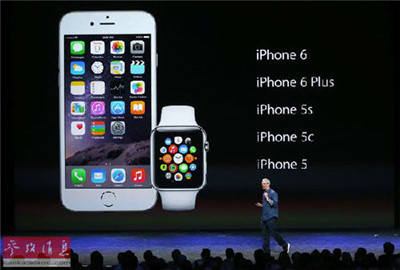(单词翻译:单击)
Soon after Apple launched its larger-screen iPhones last week, rivals in Asia sent mocking messages on Twitter, taunting it for being slow to catch up with the industry trend.
苹果(Apple)上周推出其大屏iPhone之后不久,亚洲对手们便在Twitter上发言取笑,嘲讽苹果在捕捉行业趋势上慢半拍。
“No one is going to buy a big phone,” Samsung Electronics teased, quoting a 2010 remark by Steve Jobs, Apple’s late co-founder. “Guess who surprised themselves and changed their minds?”
“永远没有人会去买大屏手机,”三星(Samsung Electronics)援引已故苹果联合创始人史蒂夫•乔布斯(Steve Jobs) 2010年的话嘲笑道,“看看是谁出尔反尔,改变了主意?”
From Taipei and Tokyo, smartphone rivals HTC and Sony sent out similarly irreverent tweets.
在台北和东京,与苹果竞争的智能手机厂家宏达电(HTC)和索尼(Sony)也在Twitter上发出类似的不敬之辞。

The light-hearted tone of the messages concealed a serious headache for Apple’s Asian competitors. While they have often moved into new product areas such as large-screen phones, smartwatches and payment technology before the US tech group, they have consistently been unable to match the excitement generated by Apple product launches – or its success in monetising and globalising their usage.
这些言论的轻松语气背后,隐藏着苹果的亚洲竞争对手们一个极其头疼的问题。尽管它们经常抢在这家美国科技集团前面进入新的产品领域,比如大屏手机、智能手表和支付技术,但它们一直无法引起像苹果产品发布那种程度的兴奋情绪,在创收和行销全球方面也未能取得苹果那样的成功。
The latest iterations of the iPhone have larger screens, taking Apple into the “phablet” territory pioneered by Samsung, which launched the fourth version of its Galaxy Note this month .
最新推出的大屏iPhone,把苹果带入了由三星开创的“平板手机”领域。三星本月发布了第4代Galaxy Note。
“When the Note was announced, I couldn’t understand it,” said Ben Wood at the research group CCS Insight, referring to the 2011 launch of Samsung’s first phablet. “It looked ridiculous. And now it’s become a legitimate category.”
“当初Galaxy Note宣布上市时,我根本不能理解它,”研究集团CCS Insight的本•伍德(Ben Wood)在评论2011年三星发布首款平板手机时表示,“它看起来很可笑。现在它成了一个正经的品类。”
Samsung would not reveal how many it has sold, but said it shipped 10m units of the previous model in the first two months after its launch last year.
三星不愿披露Galaxy Note销量有多大,但表示,上一代Note在去年推出后,头两个月的发货量达到1000万部。
Still, analysts believe that Apple’s lead in branding – despite Samsung’s marketing spending, which reached $14bn last year – will eat into the Korean group’s first-mover advantage. “Consumers have an incredible emotional engagement with the Apple brand,” said Mr Wood. “Samsung hasn’t achieved that.”
话虽如此,分析师认为,尽管三星去年营销支出达140亿美元,但苹果在品牌操作上的领导地位将削弱这家韩国集团的先发优势。“消费者对于苹果品牌有一种令人难以置信的情感投入,”伍德说,“三星还做不到这一点。”
If Samsung’s advertising has at least helped it narrow the popularity gap with Apple, Taiwan’s HTC shows the challenges facing smaller producers seeking to compete at the market’s high end.
如果说三星的广告起码帮它在人气上缩小了与苹果的差距,那么台湾宏达电的境况彰显了中小厂商在高端市场竞争时面临的种种挑战。
While its One series of phones have been praised by some as the most attractively designed smartphone, the lack of marketing clout to support it has left the company floundering. HTC is predicting a 12th consecutive quarter of declining revenues in the third quarter of this year.
尽管宏达电One系列手机被有些人誉为最具设计魅力的智能手机,但支撑增长的营销实力不足,导致该公司苦苦挣扎。宏达电预计,今年第3季度营收将连续第12个季度下滑。
The smartwatch sector reveals a similar story. Samsung is the leader by volume sales, having released five models since the first Galaxy Gear was unveiled a year ago. The company “is ahead on technology”, said Mark Newman, analyst at Bernstein, arguing that the group has “positioned itself well for the next decade of growth” in wearable electronics. Its South Korean rival LG Electronics launched its G Watch in July with an improved version to follow this year. Yet neither of these launches came close to matching the hype around the Apple Watch. “Apple understands the watch business better than Samsung,” said Daniel Kim, an analyst at Macquarie, noting Apple’s poaching of executives from the fashion industry such as Angela Ahrendts from Burberry. “Samsung’s smartwatches look ugly and there is a lack of useful apps.”
智能手表领域也呈现出类似情形。三星是销量的领先者,自从去年推出第一款Galaxy Gear之后,又发布了5款产品。伯恩斯坦(Bernstein Research)分析师马克•纽曼(Mark Newman)表示,该公司“在技术上走在前面”。他认为,这家集团“面向未来10年可穿戴设备业务的增长处于有利地位”。三星的韩国对手LG电子(LG Electronics)于7月推出了G Watch,今年还将推出改进款。但是,这些产品的发布都比不上围绕Apple Watch的大肆炒作。“苹果比三星更懂手表业务,”麦格理(Macquarie)分析师丹尼尔•金姆(Daniel Kim)说。他提到,苹果从时尚业挖来一些高官,比如博柏利(Burberry)的安杰拉•阿伦茨(Angela Ahrendts)。他说,“三星智能手表很难看,有用的应用也不多。”
Corporate Japan abounds with innovations that failed to become global hits. The Japanese call this “Galápagos syndrome”, whereby groups forge into new technological territory but fail to find a market abroad, only for foreign rivals to take the idea global.
日本企业推出的创新产品非常多,但大多未能在全球打响。日本人把这一现象称为“加拉帕戈斯群岛综合征”(Galapagos syndrome),指企业集团进入了新技术领域,但未能在国外开辟出相应市场,结果是让外国竞争借鉴创意,推出全球抢手的产品。
In 1999, Kyocera launched the world’s first mobile phone with a built-in camera and sparked the cameraphone boom in Japan, years before it became commonplace elsewhere. In 2004 Sony came out with an ebook reader three years before Amazon’s Kindle, but lost out because of higher prices and a narrower range. The company also launched a smartwatch in 2010.
1999年,京瓷(Kyocera)推出了全球首款内置摄像头的手机,在日本引爆照相手机热潮,多年之后照相手机才在世界其他地区成为潮流。2004年,索尼亚推出了一款电子书阅读器,比亚马逊(Amazon)的Kindle早三年,但最终因为价格高、选择少而落败。索尼在2010年还推出过一款智能手表。
Analysts said that Japanese companies are often content with being the first to market the latest technology but are less successful at showing consumers how those technologies will make their lives easier. “The obsession with technology overlooks what is really needed to convince the consumer to buy: the ease to use. And that’s what Apple has capitalised on,” said Atul Goyal, analyst at Jefferies.
分析师们表示,日本企业经常满足于抢先把最新科技推向市场,但不太擅长向消费者展示这些科技如何能够为他们的生活提供便利。杰富瑞(Jefferies)分析师阿图尔•戈亚尔(Atul Goyal)表示,“它们醉心于技术,而忽略了劝服消费者购买所需的因素:易用性。苹果正是利用了这一点。”
Mobile payments are the latest example. Ten years ago, NTT DoCoMo introduced phones dubbed osaifu-keitai, or mobile wallets, running on Sony’s FeliCa technology, an early form of the near-field communication technology that will be used by Apple Pay. Nearly half of Japan’s mobile phone owners use FeliCa.
最新的例子是手机支付。10年前,NTT DoCoMo便推出了具有“手机钱包”(osaifu-keitai)功能的手机。手机钱包所依赖的索尼FeliCa卡技术,是近场通信(NFC)技术的一种早期版本,NFC技术如今也将应用到Apple Pay上。在日本,将近一半的手机用户使用FeliCa卡。
Yet NTT DoCoMo and Sony have struggled to export the concept of using mobile phones as wallets. Only in Hong Kong, where FeliCa chips were used to create Octopus smart cards in 1997 and for mobile payments from last year, has it had success.
不过,NTT DoCoMo和索尼一直没能把“手机钱包”的理念输出到国外。只是在香港,FeliCa芯片于1997年被用于创建八达通卡(Octopus),从去年开始用于手机支付。
“We went in too early and the environment wasn’t ripe,” said an executive at FeliCa Networks this year.
FeliCa Networks一名高管今年表示,“我们进入得太早,而当时环境并不成熟。”
Critics say Japanese companies focus too much on perfecting their technologies in their home market, leading to a system or standard unique to Japan. In the US and Europe, Sony was unable to convince carriers, transport operators and others to adopt FeliCa since those markets used differing types of contactless pay technology.
批评者表示,日本企业太过关注于在本国市场完善自己的技术,导致了一种仅适合日本的制式或标准。在美国和欧洲,索尼没办法说服运营商、运输经营企业和其他公司采用FeliCa,因为欧美市场使用的是不同类型的非接触式支付技术。
Yasutoshi Kikuchi, partner at Roland Berger, the consultants, added that Sony needs to shift away from gadget-making and focus on where it can generate revenue. Apple’s success, for example, stems from its ability to tap into existing users by offering not only new devices but added services such as the iTunes store.
咨询公司罗兰贝格(Roland Berger)合伙人Yasutoshi Kikuchi补充道,索尼需要超越设备制造,转而专注于能够产生营收的领域。例如,苹果的成功,源于其有能力在推出新产品的同时提供iTunes store等附加服务,充分利用现有的用户群体创收。
In the same way, Sony is trying to build the PlayStation gaming console into a subscription-based platform, bringing together users of various gadgets from mobile phones, televisions, tablets to portable game players with wide-ranging offerings from games and movies to live TV programmes.
同样地,索尼正努力把PlayStation游戏机打造为一个订购平台,以便汇聚广泛的产品与服务(从游戏、电影,到实况电视节目),面向各种设备(手机、电视机、平板电脑和掌上游戏机)的用户。


